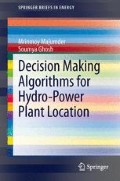Abstract
Nature-based algorithms are those algorithms which mimics nature to solve a real-life problem. This kind of meta-heuristic algorithms are popular to search for an optimal answer within a given set of nonlinear complex problems by replicating the way by which nature is solving its problems. For example, bat search for food with the help of the emitted sonar signal which accurately identifies the location of ideal sources of food. This same concept can be replicated in case of real-life problems to estimate the ideal solution of nonlinear problems. In this chapter, the concepts of neural network, fuzzy logic, bat algorithm, and Analytical Hierarchy Process which are applied in the present study for taking a scientific decision in regard to find a suitable location for hydropower plants.
Access this chapter
Tax calculation will be finalised at checkout
Purchases are for personal use only
References
A. Adib, Determining water surface elevation in tidal rivers by ANN. Proceedings of the ICE-Water Management 161(2), 83–88 (2008)
M. Agarwal, K.B. Kanad, H. Madasu, Generalized intuitionistic fuzzy soft sets with applications in decision-making. Appl. Soft. Comput. (2013)
X.-S. Yang, A New Metaheuristic Bat-Inspired Algorithm, in Nature Inspired Cooperative Strategies for Optimization (NISCO 2010) (Eds. J.R. Gonzalez et al.), Studies in Computational Intelligence, 284 (Springer, Berlin, 2010), pp. 65–74
Y.L. Cavalcante, R.A. Hauser-Davis, A.C.F. Saraiva, I.L.S. Brandão, T.F. Oliveira, and A.M. Silveira, Metal and physico-chemical variations at a hydroelectric reservoir analyzed by multivariate analyses and artificial neural networks: Environmental management and policy/decision-making tools. Science of the Total Environment 442, 509–514 (2013)
T. Cay, U. Mevlut, Evaluation of reallocation criteria in land consolidation studies using the Analytic Hierarchy Process (AHP). Land Use Policy 30(1), 541–548 (2013)
Y.-H. Chang, C.-H. Yeh, Y.-W. Chang, A new method selection approach for fuzzy group multicriteria decision making. Appl. Soft. Comput. (2013)
K. Deb, A. Samir, P. Amrit, M. Tanaka, A fast elitist non-dominated sorting genetic algorithm for multi-objective optimization: NSGA-II. Lecture notes in computer science 1917, 849–858 (2000)
M. Doumpos, G. Evangelos, Multicriteria decision aid and artificial intelligence: links, theory and applications. Wiley-Blackwell, (2013)
M.F. Moghadam, S. Haghighipour, H. Mohammad Vali Samani, Design-variable optimization of hydropower tunnels and surge tanks using a genetic algorithm. J. Water. Res. Planning. Manag. 139(2), 200–208 (2013)
M. Fedrizzi, F. Michele, R.A.P. Marques, Consensus modelling in group decision making: A dynamical approach based on zadeh’s fuzzy preferences. In On Fuzziness. (Springer, Berlin Heidelberg, 2013), pp. 165–170
X. Hu, C. Henning, H.A. Meyer, M. Kurt, J. Klaus, S. Carsten, Artificial neural networks and prostate cancer—tools for diagnosis and management. Nat. Rev. Urol. (2013)
H.Z. Huang, Q. Jian, J.Z. Ming, Genetic-algorithm-based optimal apportionment of reliability and redundancy under multiple objectives. IIE Transactions 41(4), 287–298 (2009)
V. Jothiprakash, R. Arunkumar, Optimization of hydropower reservoir using evolutionary algorithms coupled with chaos. Water. Res. Manag. 1–17 (2013)
M. Kazemi, Prioritizing factors affecting bank customers using kano model and analytical hierarchy process. Int. J. Account. Financ. Manag. 6 (2013)
S.Y. Kim, Hybrid forecasting system based on case-based reasoning and analytic hierarchy process for cost estimation. J. Civil. Eng. Manag. 19(1), 86–96 (2013)
P. Klungboonkrong, A.P.T. Michael, Application of knowledge-based expert system, Analytic hierarchy process and fuzzy set theory in multicriteria environmental sensitivity evaluation of the urban road network. KKU Eng. J. 25(1), 1–20 (2013)
K. Krishnakumar, D. E. Goldberg. Control system optimization using genetic algorithms. J. Guidance. Control. Dyn. 15(3), 735–740 (1992)
J. Li, Z. Zheng, F. Yu, and Z. Xiumei, Use of genetic-algorithm-optimized back propagation neural network and ordinary kriging for predicting the spatial distribution of groundwater quality parameter. In 2012 International Conference on Graphic and Image Processing. Int. Soc. Optics. Photonics. pp. 87684V–87684V (2013)
H.-H. Liu, T.-Y. Chen, Y.-H. Chiu, F.-H. Kuo, A comparison of three-stage DEA and artificial neural network on the operational efficiency of semi-conductor firms in Taiwan. (2013)
J.G. Liu, W. Yongchang, T. Tingting, C. Qingquan, Research and development of decision support system for regional agricultural development programming. In Computer and Computing Technologies in Agriculture VI. (Springer Berlin Heidelberg, 2013) pp. 271–281
K.D. Maniya, M.G. Bhatt, A selection of optimal electrical energy equipment using integrated multi criteria decision making methodology. Int. J. Energy. Optim. Eng. 2(1), 101–116 (2013)
M.M. Garrett, D.S. Goodsell, R.S. Halliday, R. Huey, W.E. Hart, R.K. Belew, A.J. Olson, Automated docking using a lamarckian genetic algorithm and an empirical binding free energy function. J. Comput. Chem. 19(14), 1639–1662 (1998)
O. Penangsang, A. Muhammad, R.S. Wibowo, S. Adi, Optimal design of photovoltaic–battery systems using interval type-2 Fuzzy Adaptive Genetic Algorithm. (2013)
R. Venkata, Applications of improved MADM methods to the decision making problems of manufacturing environment. In Decision Making in Manufacturing Environment Using Graph Theory and Fuzzy Multiple Attribute Decision Making Methods. (Springer London, 2013) pp. 41–135
C.-X. Ren, C.-B. Wang, C.-C Yin, M. Chen, S. Xu, The prediction of short-term traffic flow based on the niche genetic algorithm and BP neural network. In Proceedings of the 2012 International Conference on Information Technology and Software Engineering. (Springer Berlin Heidelberg, 2013) pp. 775–781
Xi, Jun, Y. Xue, Y. Xu, and Y. Shen, Artificial neural network modeling and optimization of ultrahigh pressure extraction of green tea polyphenols. Food Chemistry (2013)
Y.R. Ronald, Using agent importance to combat preference manipulation in group decision making. In Multicriteria and Multiagent Decision Making with Applications to Economics and Social Sciences. (Springer Berlin Heidelberg, 2013), pp. 301–313
F. Zahedi, The analytic hierarchy process—a survey of the method and its applications. Interfaces 16(4), 96–108 (1986)
Author information
Authors and Affiliations
Corresponding author
Rights and permissions
Copyright information
© 2013 The Author(s)
About this chapter
Cite this chapter
Majumder, M., Ghosh, S. (2013). Nature-Based Algorithms. In: Decision Making Algorithms for Hydro-Power Plant Location. SpringerBriefs in Energy. Springer, Singapore. https://doi.org/10.1007/978-981-4451-63-5_4
Download citation
DOI: https://doi.org/10.1007/978-981-4451-63-5_4
Published:
Publisher Name: Springer, Singapore
Print ISBN: 978-981-4451-62-8
Online ISBN: 978-981-4451-63-5
eBook Packages: EnergyEnergy (R0)

